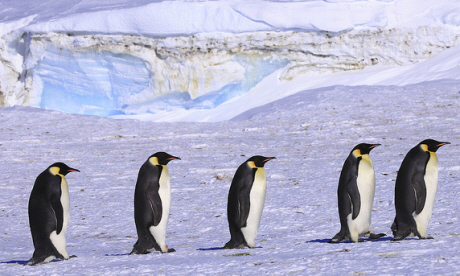
Everyone loves watching these adorable sea birds sliding around on their bellies, so here's our pick of the places you're most likely to find them
The largest of all penguins at almost 4ft tall, the Emperor penguin lives in the coldest climate on earth, where temperatures can reach -60C. During the freezing Antarctic winter, female Emperors transfer their egg to the feet of the males to incubate while they feed in the sea. Over the harsh winter, the males do not eat and huddle in groups to stay warm.
These little cuties with massive eyebrows got their name from their odd habit of hopping, rather than waddling, among craggy, windswept shorelines of the islands of north Antarctica from Chile to New Zealand. These sociable marine birds are among the world's smallest penguins at only 50cm high. They have blood red eyes, an orange beak and pink webbed feet.
The Falkland islands have some of the world's largest Rockhopper colonies and can be found on the north coast at Cape Bougainville. The Cape is reached from Salvador by off-road tracks, so hire a driver or guide who understands the terrain and techniques to cross it.
Yes, you can find penguins on the equator! The Galápagos penguin is the most northerly of all penguins and stands at only 14 inches high. These small penguins were brought to the Galápagos by the Humboldt Current, which runs from Antarctica up the west coast of South America, bringing cold water and nutrients with it. The Galápagos penguin mates for life and the mating season is year-round. They breed mainly in caves or crevices of old lava flows and in burrows.
The total population of the Galápagos penguin is only a couple of thousand and they have been declared endangered. They can be found on Fernandina, Isabela, Santiago, Bartolome (where display and mating can be seen), northern Santa Cruz and Floreana. It is rare to see penguins on the other islands.
No other bird on earth breeds further south than the tobogganing Adelie penguin. This medium sized penguin can be recognised by a white ring around the eye and end of their bills. They mostly live on small islands off the Antarctic coast. Many believe the Adelie penguin to be a fun-loving bird as they are often seen tobogganing around the ice on their bellies. However fun this looks, these small birds use these movements to stop themselves from getting worn out when moving around on the ice.
There are an estimated five million Adelie Penguins in the Ross Sea area, all living in very large colonies. The best place to see them is Ross Island, south of New Zealand.
Funnily enough, this penguin lives up to its name of being 'little'; it is the smallest of the penguin species at only 30cm tall and weighs only 3.3lbs. The little penguin can be found on the southern shores of Australia and New Zealand, with rare sightings in Chile. The little penguin has other common names in its various homes; fairy penguin in Australia due to its tiny size and blue penguin in New Zealand because of the bird's blue feathers.
The fairy penguins are easily spotted on Phillip Island in Australia, where a viewing platform has been set up for visitors to watch the 'penguin parade' as they return to their colonies at night. Kangaroo Island is also home to the Penneshaw Penguin Centre where you can watch the little penguins waddle out of the sea and hear the chirps of little chicks waiting for mealtime.
King penguins are the second largest of all penguins and are often mistaken for the Emperor. However, unlike the Emperors, King pairs share the incubation of the egg, rather than leaving the male alone to do it. King penguins breed and live in northern Antarctica, on South Georgia and other temperate islands in the area.
The best place to spend a day with these beauties is on South Georgia. However, there are no airstrips on the island so access is only by boat. Most tourists arrive by icebreaker, however smaller boats do brave the rough passage to the island. Whether you choose to sail on a large or small boat, even those with the sturdiest of sea legs should prepare for a bout of seasickness on this voyage.
These penguins that grow no taller than 55cm in height, are rather timid and solitary. They live and breed on the south west coast of New Zealand's south island. This penguin can be identified by its blueish head and wide, yellow eyebrows. The habits of the Fiordland Penguin have been difficult for scientists to monitor due to their hidden nesting areas in thick vegetation.
The best viewing sites for these penguins are Stewart Island and Munroe Beach, New Zealand. Plan your trip between July and November for guaranteed viewing as these shy birds only stay in their breeding colonies during the season. Wilderness Lodge Lake Moeraki, South Westland, offer daily guided and tailored wildlife tours.
 For more information on the penguins on the Falkland Islands, check out Mark Stratton's article in the May 2014 issue of Wanderlust, available now.
For more information on the penguins on the Falkland Islands, check out Mark Stratton's article in the May 2014 issue of Wanderlust, available now.